For the last 2000 years, people have colonized the islands of the Pacific, so in a way it's surprising that the Galápagos remained pristine while places like New Zealand ahd Hawaii had their natural systems trashed and stomped on. Yet, in another way, it makes perfect sense. The islands simply aren't conducive to argiculture except in a few scattered places. Thus, for most of their human history, they have been the marginal habitation of marginalized people.
Discovery: 1485-1570
 1485: Incas The Inca Empire was based in the mountains of southern Peru. In 1463, they began the conquest of what is now Ecuador under Pachacuti, the 9th Inca. This conquest was essentially complete by the end of the century, and Quito, former capital of the Quitus, became the Inca's summer capital. An odd side note: Legend has it that the Inca prince and future 10th Inca, Tupac Yupanqui, organized a fleet of balsa rafts to investigate stories of uninhabited islands to the west. This expidition returned after nine months with the skin and jaws of a "horse" (probably a sea lion) and reports of two islands - One volcanic.
1485: Incas The Inca Empire was based in the mountains of southern Peru. In 1463, they began the conquest of what is now Ecuador under Pachacuti, the 9th Inca. This conquest was essentially complete by the end of the century, and Quito, former capital of the Quitus, became the Inca's summer capital. An odd side note: Legend has it that the Inca prince and future 10th Inca, Tupac Yupanqui, organized a fleet of balsa rafts to investigate stories of uninhabited islands to the west. This expidition returned after nine months with the skin and jaws of a "horse" (probably a sea lion) and reports of two islands - One volcanic.
Where did this expedition go? The Galápagos are an obvious possibility, but Easter Island has also been advocated.
(Right: The Inca Empire)
1535: Official Discovery Three years after the conquest of Peru by Spain, Spanish Bishop Fray Thomas de Berlanga, sailing from Panama to Lima, made the official discovery of the islands when his ship was becalmed and drifted off course. He described the tortoises and iguanas, and coined the name "Galápagos" after the shape of the saddle-backed tortoises. Several sightings and landings occurred in the following decades, but no one suggested that the islands were in any way useful
1570: Mapped The islands first appeared on a map as "Insulae de los Galopegos".
Accursed Islands: late 1500s-1790
During this era, the uselessness of the Galápagos to humans was a source of intellectual concern. Natural Theology, the scholarly attitude toward nature were overtly utilitarian. God had made the Earth specifically as the home of humans, and had filed it with things for them to use. A land lacking utility to humans was an intellectually ugly thing. Thus, the description of the Galápagos as "Las islas encantadas" - the accursed isles. But some people found a use for them.
 1593-1710: Pirates and Buccaneers Near the turn of the 17th century, English, French, and Dutch pirates and buccaneers finaly found a use for the Galápagos as a hide out and logistical base for raids on the coast of South America. FYI, here is a taxonomy of violent seamen.
1593-1710: Pirates and Buccaneers Near the turn of the 17th century, English, French, and Dutch pirates and buccaneers finaly found a use for the Galápagos as a hide out and logistical base for raids on the coast of South America. FYI, here is a taxonomy of violent seamen.
- Pirate: A strong-arm robber in a ship.
- Buccaneer: A pirate whose depredations, by informal arrangement, are directed against citizens of foreign/enemy powers. In exchange, the authorities of their own country leave them alone. Most of the Galápagos seamen were English buccaneers preying on Spanish victims.
- Privateer: A mercenary (Oops, scratch that. A private security contractor.) A private ship owner operating under a letter of marque - a formal authorization to attack the enemies of the state on the state's behalf and to retain booty for personal profit.
This assortment took thousands of tortoises to provision their ships and released goats to the islands to maintain a food supply in while on the Galápagos. In an early form of biological warefare, the viceroy of Peru introduced dogs to the islands to get rid of the goats, hoping to get rid of the pirates' food. This was unsuccessful; goats and dogs are two of the most devastating introduced species to the islands. Even in Darwin's time, the memory of English buccaneers was fresh in the minds of South Americans. Indeed, Darwin describes being the guest of an aristocratic family in Valparaiso and having his hostess remark that when she was young she couldn't imagine sitting down to dinner with an Englishman.
Exploitation and Study: 1790 - 20th century
1790: First Scientific Mission Alexander Malicina of Spain went to the islands for research purposes, but the reports from the expedition were lost.
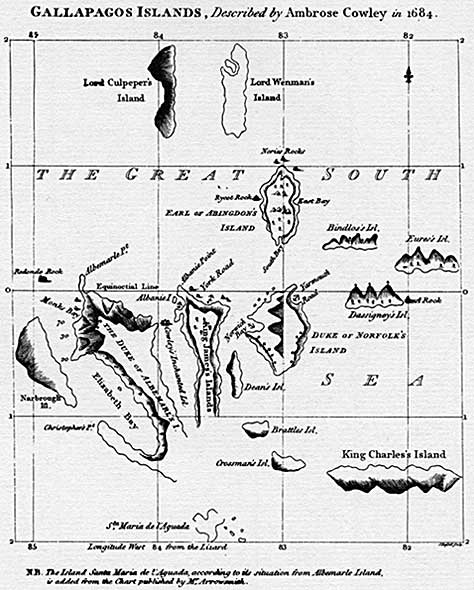 1793: Voyage of Capt. James Colnett Charged by the Admiralty with identifying whaling resources, came upon the great annual convergence of sperm whales at the islands. He visited twice over several months, concluding that God's purpose in creating the Galápagos might have been to provide a bounty of whales for human use. Colnett's age was the last major gasp of both Natural Theology and the catastrophist view that the Earth's surface was, essentially, unchanging except during a few exceptional events (E.G. Noah's Flood) when the normal laws of nature don't apply. Colnett recognized the signs of volcanic eruptions in the Galápagos but never considered that the islands were actually the tops of giant volcanoes.
1793: Voyage of Capt. James Colnett Charged by the Admiralty with identifying whaling resources, came upon the great annual convergence of sperm whales at the islands. He visited twice over several months, concluding that God's purpose in creating the Galápagos might have been to provide a bounty of whales for human use. Colnett's age was the last major gasp of both Natural Theology and the catastrophist view that the Earth's surface was, essentially, unchanging except during a few exceptional events (E.G. Noah's Flood) when the normal laws of nature don't apply. Colnett recognized the signs of volcanic eruptions in the Galápagos but never considered that the islands were actually the tops of giant volcanoes.
1793-1870: Whale Exploitation Whales are being hunted in the islands' waters. This industry reduced tortoise and fur seals populations, as well as whales.

1793: Post Office Barrel The post office barrel (right) is erected on Floreana. Visiting ships can leave letters in the barrel. These letters will stay there until a ship stops at the barrel that will be traveling in the direction of the letter's destination. The barrel was a customary stop, and still stands there today as an odd piece of tacky tourist kitch - a warning of the dangers of commercialization.
1800-1900: Fur Seal Exploitation Fur Seals are hunted nearly to their extinction by North Americans and Europeans.
1807-1812: First Permanent Settler Patrick Watkins took up residence on Floreana. Contemporary accounts describe him as monstrously deshevelled and criminally depraved. He eventually fled with the aid of five crew members of a whaling ship, whom he had effectively enslaved. It's assumed he later murdered them.
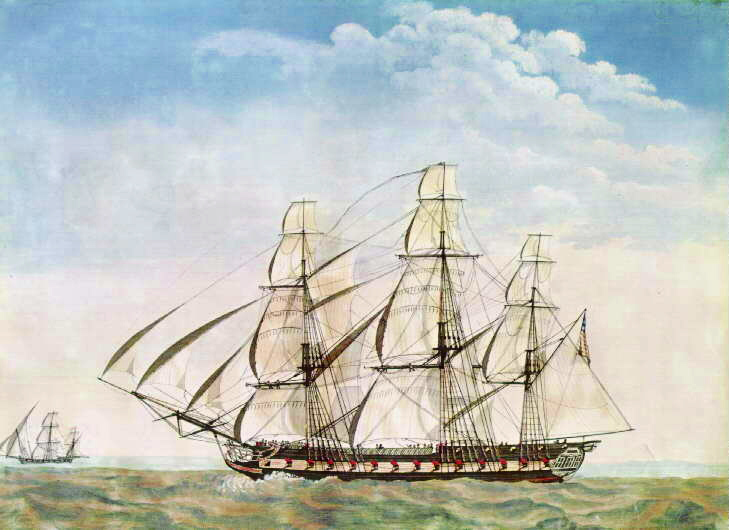 1813: Final shots fired in anger American Capt. David Porter attacks and captures the British whaling fleet during the war of 1812. He is the historical prototype of the French bad guys in Master and Commander. Unlike the fictional French, he won. Porter operated out of the for Galápagos for six months, making natural history observations. His narrative, Journal of a Cruise Made to the Pacific has a different tone than that of Colnett. Porter identifies the Islands as changing landscapes formed by ongoing volcanic eruptions. He correctly identified Fernandina and Isabela as the youngest islands, and San Cristóbal and Española as the oldest.
1813: Final shots fired in anger American Capt. David Porter attacks and captures the British whaling fleet during the war of 1812. He is the historical prototype of the French bad guys in Master and Commander. Unlike the fictional French, he won. Porter operated out of the for Galápagos for six months, making natural history observations. His narrative, Journal of a Cruise Made to the Pacific has a different tone than that of Colnett. Porter identifies the Islands as changing landscapes formed by ongoing volcanic eruptions. He correctly identified Fernandina and Isabela as the youngest islands, and San Cristóbal and Española as the oldest.
Why so different from Colnett? During the interval between their visits, James Hutton's Theory of the Earth had been published, introducing the concept of Uniformitarianism. Porter would have sprung from educated circles in which the idea had been discussed.
1835: H.M.S. Beagle The young Charles Darwin visits during the voyage of the H. M. S. Beagle. Darwin, of course, had read Principles of Geology by Hutton's disciple, Charles Lyell, and applied the uniformitarian viewpoint to both geologic and biological phenomena.
Annexation and Settlement: 1832 - 20th century
1832: "Archipelago de Ecuador" Since Watkins' departure, the islands had lacked permanent inhabitants. This changed when Ecuador officially annexed the islands. They give the archipelago the name "Archipelago de Ecuador", and give the islands their Spanish names. A colony was established on Floreana by Gen. José Villamil, one of Ecuador's founding fathers. Not long after Villamil's departure, the Floreana colony was converted to a penitentiary, primarily for political prisoners and prostitutes.
1869: An officer named Manuel Cobos came from the mainland with soldiers imprisoned for rebellion and established a sugar plantation and refinery. He is known as the "Dog King" of Charles Islands because he is said to have controlled his prisoners with dogs and treated them as slaves, and to have abused the wives of his subordinates. Nasty guy by all accounts. After Cobos' overthrow in 1904, the domesticated animals within their penal colony were released and became feral.
1886: School Set Up on Floreana A small school was set up on Floreana for children.
1892: "Archipelago de Colon" The official name of the islands changes from the "Archipelago de Ecuador" to the "Archipelago de Colon" in honor of Christopher Columbus's "discovery" of the Americas four hundred years earlier.
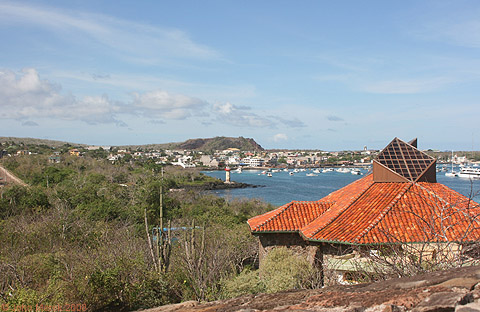 1885: Puerto Baquerizo Moreno In the 50 years of Ecuadorian rule, several attempts at colonization had failed. Finally a successful colony was established at Puerto Baquerizo Moreno on San Cristobal.
1885: Puerto Baquerizo Moreno In the 50 years of Ecuadorian rule, several attempts at colonization had failed. Finally a successful colony was established at Puerto Baquerizo Moreno on San Cristobal.
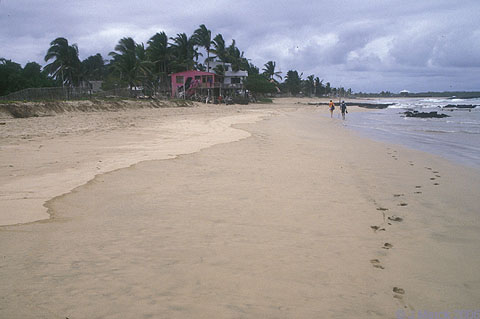 1893: Puerto Villamil Established on southern Isabela.
1893: Puerto Villamil Established on southern Isabela.
1905-1906: California Academy of Science Scientists come to the islands and make the first extensive research and collections on the islands. This is, effectively the last large scale research expedition in the 19th century style. Subsequently smaller-scale research sponsored by private donors and universities.
1923: William Beebe A famous scientist of his time, Beebe writes a book called Galápagos: World's End. This brought attention to the islands from all around the world and inspired people to move to the islands.
1924-1930: First Commercial Production of Salt Salt mines were established on Santiago by Mr. Egas. This was a successful industry until the national park bought their lands in 1950.
Early 20th century idealists
The devastation of Europe during the First World War created a generation of emotionally scarred people seeking a better life. Some, like Sir Arthur Conan Doyle, stayed home and became spritualists. Others sought the isolation of the Galápagos in which to build their Utopias:
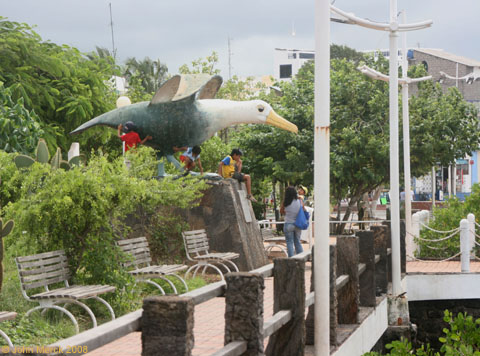 1926: Norwegians Norwegians try to colonize the Galápagos. They lured workers from Norway through advertisements promising a tropical paradise, many found this was far from the truth. They came to the islands and started a short lived fishing industry, some descendants can still be found living on Santa Cruz and San Cristóbal. Their lasting legacy is the town of Puerto Ayora on southern Santa Cruz.
1926: Norwegians Norwegians try to colonize the Galápagos. They lured workers from Norway through advertisements promising a tropical paradise, many found this was far from the truth. They came to the islands and started a short lived fishing industry, some descendants can still be found living on Santa Cruz and San Cristóbal. Their lasting legacy is the town of Puerto Ayora on southern Santa Cruz.
 1928: Dr. Ritter Dr. Friedrich Ritter, a German physician and grandiose would-be Nietschean superman sets up housekeeping on Floreana in the company of his companion, Dora Strauch.
(Image thanks to Rolf Wittmer.com.)
1928: Dr. Ritter Dr. Friedrich Ritter, a German physician and grandiose would-be Nietschean superman sets up housekeeping on Floreana in the company of his companion, Dora Strauch.
(Image thanks to Rolf Wittmer.com.)
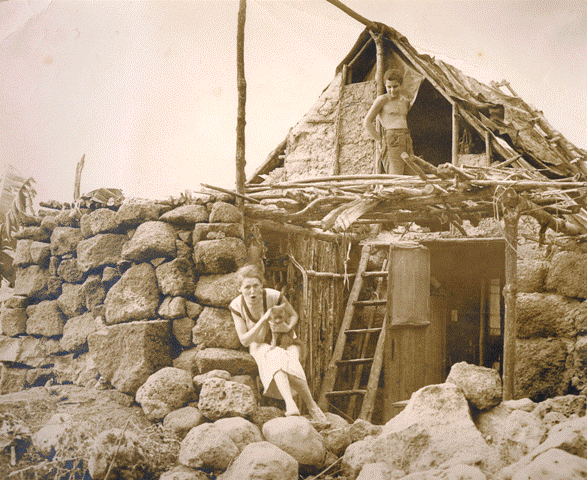 1932: Wittmers The Wittmer family, Margret and Heinz, move to Floreana seeking a better life for their disabled son. Of this generation of Floreana settlers, only the Wittmers were successful. Indeed, Margaret Wittmer (right) only passed away in 2000, and the Wittmer family remains well-established there. At this point, Floreana, with its eccentric "Robinson Crusoes" became a port of call for wealthy yachtsmen.
(Image thanks to Rolf Wittmer.com.)
1932: Wittmers The Wittmer family, Margret and Heinz, move to Floreana seeking a better life for their disabled son. Of this generation of Floreana settlers, only the Wittmers were successful. Indeed, Margaret Wittmer (right) only passed away in 2000, and the Wittmer family remains well-established there. At this point, Floreana, with its eccentric "Robinson Crusoes" became a port of call for wealthy yachtsmen.
(Image thanks to Rolf Wittmer.com.)
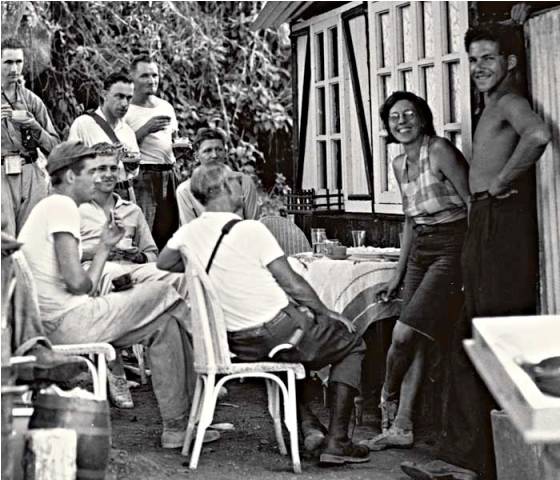 1933: "Queen of Floreana" A self proclaimed German "Baroness Eloise Wehrborn von Wagner de Bosquet" arrived on Floreana with three male companions, two Germans (Lorenz and Philipson) and one Ecuadorian. Her aim was to establish a hotel for wealthy yachtsmen, the Hacienda Paraiso, but succeeded in constructing only a corrugated tin shack with the help of her long-suffering love slaves. The Ecuadorian soon took off, leaving the two Germans to vie for her favors. Eventually Philipson was ensconced as number one lover while Lorenz was treated like a dog.
(Image thanks to Rolf Wittmer.com.)
1933: "Queen of Floreana" A self proclaimed German "Baroness Eloise Wehrborn von Wagner de Bosquet" arrived on Floreana with three male companions, two Germans (Lorenz and Philipson) and one Ecuadorian. Her aim was to establish a hotel for wealthy yachtsmen, the Hacienda Paraiso, but succeeded in constructing only a corrugated tin shack with the help of her long-suffering love slaves. The Ecuadorian soon took off, leaving the two Germans to vie for her favors. Eventually Philipson was ensconced as number one lover while Lorenz was treated like a dog.
(Image thanks to Rolf Wittmer.com.)
1934: Mysterious Disappearances and Deaths One dark night, the Baroness and Philipson simply disappeared. Lorenz attempted to flee the island on a passing power-yacht, however this led to disaster when it was wrecked on the shores of Marchena. Apparantly Lorenz and his would-be savior survived the wreck only to die later of dehydration. Ecuadorian and German authorities, while suspecting much foul play, never pressed charges. Soon thereafter, Friedrich Ritter died of botulism poisoning and Dora, never a really good cook, returned to Germany.
(Image thanks to Rolf Wittmer.com.)
First laws specifically addressing protection of Galápagos in 1934. Some islands
become reserves for a natural park: did not include Santa Cruz, Floreana, San Cristobal,
or south Isabela and Fernandina.
1941: Americans on Baltra The U. S. Army Air Corp extablishes a base on Baltra as a defense against a Japanses attack on the Panama Canal. Bored airmen exterminate local land iguanas, but not before many are evacuated to North Seymour. Some evacuees continue to live there.












